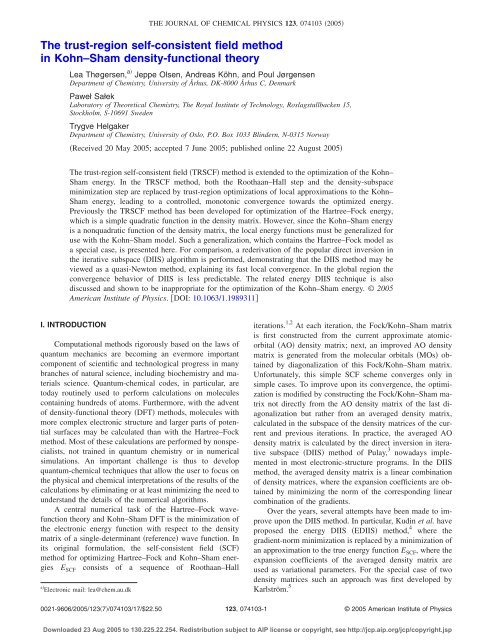Get my PhD Thesis
Get my PhD Thesis
Get my PhD Thesis
You also want an ePaper? Increase the reach of your titles
YUMPU automatically turns print PDFs into web optimized ePapers that Google loves.
THE JOURNAL OF CHEMICAL PHYSICS 123, 074103 2005<br />
The trust-region self-consistent field method<br />
in Kohn–Sham density-functional theory<br />
Lea Thøgersen, a Jeppe Olsen, Andreas Köhn, and Poul Jørgensen<br />
Department of Chemistry, University of Århus, DK-8000 Århus C, Denmark<br />
Paweł Sałek<br />
Laboratory of Theoretical Chemistry, The Royal Institute of Technology, Roslagstullbacken 15,<br />
Stockholm, S-10691 Sweden<br />
Trygve Helgaker<br />
Department of Chemistry, University of Oslo, P.O. Box 1033 Blindern, N-0315 Norway<br />
Received 20 May 2005; accepted 7 June 2005; published online 22 August 2005<br />
The trust-region self-consistent field TRSCF method is extended to the optimization of the Kohn–<br />
Sham energy. In the TRSCF method, both the Roothaan–Hall step and the density-subspace<br />
minimization step are replaced by trust-region optimizations of local approximations to the Kohn–<br />
Sham energy, leading to a controlled, monotonic convergence towards the optimized energy.<br />
Previously the TRSCF method has been developed for optimization of the Hartree–Fock energy,<br />
which is a simple quadratic function in the density matrix. However, since the Kohn–Sham energy<br />
is a nonquadratic function of the density matrix, the local energy functions must be generalized for<br />
use with the Kohn–Sham model. Such a generalization, which contains the Hartree–Fock model as<br />
a special case, is presented here. For comparison, a rederivation of the popular direct inversion in<br />
the iterative subspace DIIS algorithm is performed, demonstrating that the DIIS method may be<br />
viewed as a quasi-Newton method, explaining its fast local convergence. In the global region the<br />
convergence behavior of DIIS is less predictable. The related energy DIIS technique is also<br />
discussed and shown to be inappropriate for the optimization of the Kohn–Sham energy. © 2005<br />
American Institute of Physics. DOI: 10.1063/1.1989311<br />
I. INTRODUCTION<br />
Computational methods rigorously based on the laws of<br />
quantum mechanics are becoming an evermore important<br />
component of scientific and technological progress in many<br />
branches of natural science, including biochemistry and materials<br />
science. Quantum-chemical codes, in particular, are<br />
today routinely used to perform calculations on molecules<br />
containing hundreds of atoms. Furthermore, with the advent<br />
of density-functional theory DFT methods, molecules with<br />
more complex electronic structure and larger parts of potential<br />
surfaces may be calculated than with the Hartree–Fock<br />
method. Most of these calculations are performed by nonspecialists,<br />
not trained in quantum chemistry or in numerical<br />
simulations. An important challenge is thus to develop<br />
quantum-chemical techniques that allow the user to focus on<br />
the physical and chemical interpretations of the results of the<br />
calculations by eliminating or at least minimizing the need to<br />
understand the details of the numerical algorithms.<br />
A central numerical task of the Hartree–Fock wavefunction<br />
theory and Kohn–Sham DFT is the minimization of<br />
the electronic energy function with respect to the density<br />
matrix of a single-determinant reference wave function. In<br />
its original formulation, the self-consistent field SCF<br />
method for optimizing Hartree–Fock and Kohn–Sham energies<br />
E SCF consists of a sequence of Roothaan–Hall<br />
a Electronic mail: lea@chem.au.dk<br />
iterations. 1,2 At each iteration, the Fock/Kohn–Sham matrix<br />
is first constructed from the current approximate atomicorbital<br />
AO density matrix; next, an improved AO density<br />
matrix is generated from the molecular orbitals MOs obtained<br />
by diagonalization of this Fock/Kohn–Sham matrix.<br />
Unfortunately, this simple SCF scheme converges only in<br />
simple cases. To improve upon its convergence, the optimization<br />
is modified by constructing the Fock/Kohn–Sham matrix<br />
not directly from the AO density matrix of the last diagonalization<br />
but rather from an averaged density matrix,<br />
calculated in the subspace of the density matrices of the current<br />
and previous iterations. In practice, the averaged AO<br />
density matrix is calculated by the direct inversion in iterative<br />
subspace DIIS method of Pulay, 3 nowadays implemented<br />
in most electronic-structure programs. In the DIIS<br />
method, the averaged density matrix is a linear combination<br />
of density matrices, where the expansion coefficients are obtained<br />
by minimizing the norm of the corresponding linear<br />
combination of the gradients.<br />
Over the years, several attempts have been made to improve<br />
upon the DIIS method. In particular, Kudin et al. have<br />
proposed the energy DIIS EDIIS method, 4 where the<br />
gradient-norm minimization is replaced by a minimization of<br />
an approximation to the true energy function E SCF , where the<br />
expansion coefficients of the averaged density matrix are<br />
used as variational parameters. For the special case of two<br />
density matrices such an approach was first developed by<br />
Karlström. 5<br />
0021-9606/2005/1237/074103/17/$22.50<br />
123, 074103-1<br />
© 2005 American Institute of Physics<br />
Downloaded 23 Aug 2005 to 130.225.22.254. Redistribution subject to AIP license or copyright, see http://jcp.aip.org/jcp/copyright.jsp

















